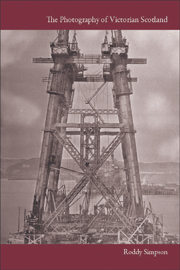Book contents
- Frontmatter
- Contents
- List of Figures
- Introduction
- 1 The Origins of Scottish Photography: Pioneering Activities in St Andrews and Edinburgh
- 2 David Octavius Hill and Robert Adamson: the ‘Partnership of Genius’ and the First Art Photography
- 3 Photography for the Few: The Activities of the Enthusiastic and Artistic Amateurs
- 4 Photography in Demand: The Work of the Increasing Number of Professional Photographers to Meet Public Demand
- 5 Scots Abroad: The Achievements of Scottish Photographers Around the World
- 6 Tourists and Travellers: Images of Scotland Produced for the Rapidly Growing Tourist Market and Photographs Taken by Visitors
- 7 Recording Social Conditions and Industrial Change: Photographs of what was Being Lost and what was Replacing it
- 8 Photography as Art: Looking at the Images and the Arguments
- 9 Populist Activity and Pictorialism: Popular Involvement with Cheap and Mass Produced Cameras and Photographers with Artistic Aspirations
- 10 Scotland's Enduring Photographic Legacy
- Bibliography
- Acknowledgements
- Index
1 - The Origins of Scottish Photography: Pioneering Activities in St Andrews and Edinburgh
Published online by Cambridge University Press: 05 August 2013
- Frontmatter
- Contents
- List of Figures
- Introduction
- 1 The Origins of Scottish Photography: Pioneering Activities in St Andrews and Edinburgh
- 2 David Octavius Hill and Robert Adamson: the ‘Partnership of Genius’ and the First Art Photography
- 3 Photography for the Few: The Activities of the Enthusiastic and Artistic Amateurs
- 4 Photography in Demand: The Work of the Increasing Number of Professional Photographers to Meet Public Demand
- 5 Scots Abroad: The Achievements of Scottish Photographers Around the World
- 6 Tourists and Travellers: Images of Scotland Produced for the Rapidly Growing Tourist Market and Photographs Taken by Visitors
- 7 Recording Social Conditions and Industrial Change: Photographs of what was Being Lost and what was Replacing it
- 8 Photography as Art: Looking at the Images and the Arguments
- 9 Populist Activity and Pictorialism: Popular Involvement with Cheap and Mass Produced Cameras and Photographers with Artistic Aspirations
- 10 Scotland's Enduring Photographic Legacy
- Bibliography
- Acknowledgements
- Index
Summary
The practical invention of photography is historically accepted as dating from January 1839 and Scotland embraced it with unrivalled enthusiasm. In that month in Paris, Louis Jacques Mandé Daguerre announced his daguerreotype process, shortly followed by William Henry Fox Talbot in London of his photogenic drawings. Both processes will be looked at but there were antecedents to these public announcements of the invention of photography and, more importantly, there were photographs before 1839.
Photography was not an invention out of the blue, there was no ‘eureka’ moment, it had a pre-history and some of the equipment for photography was used for other purposes and the properties of certain chemicals to react to light was also known.
It is worth bearing in mind that there were cameras before photography as this helps to set the context for the invention of photography. The optical principle of the camera obscura had been known to Aristotle in the fourth century BC and in China about the same time observations about the camera obscura were recorded. In it simplest form the camera obscura is a dark room with a very small hole in one wall. This is the only source of light and through this is projected the scene outside which appears inverted on the opposite wall. The size of the hole determines the sharpness and brightness of the image. In the early twelfth century the Arab scholar Ibn Ál-Haithan (Alhazen) stressed the significance between the sharpness of the image and the size of the aperture.
- Type
- Chapter
- Information
- The Photography of Victorian Scotland , pp. 3 - 20Publisher: Edinburgh University PressPrint publication year: 2012

